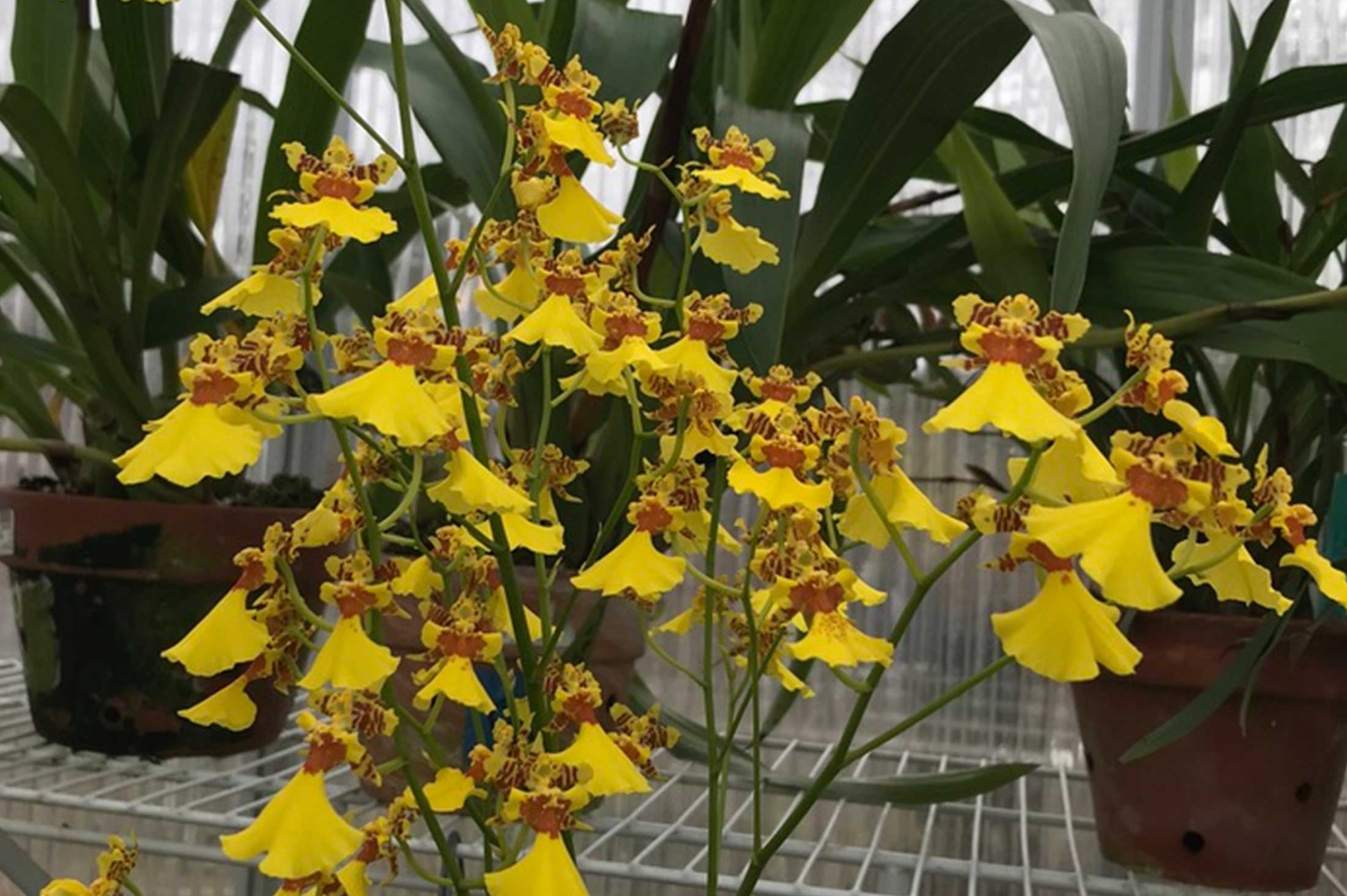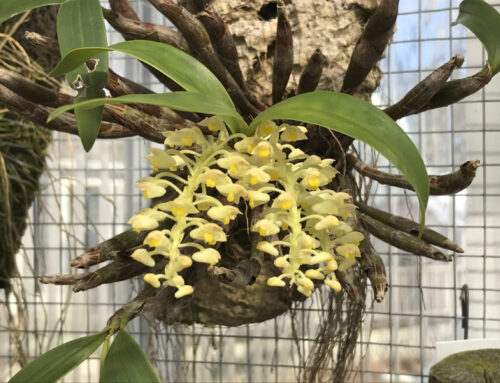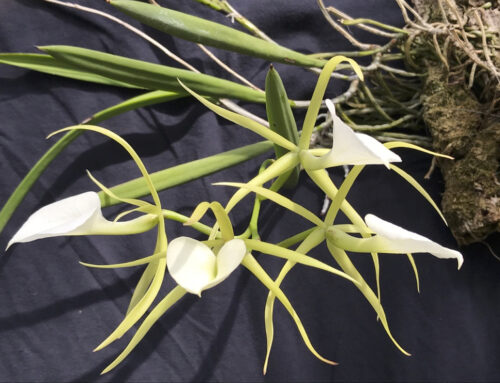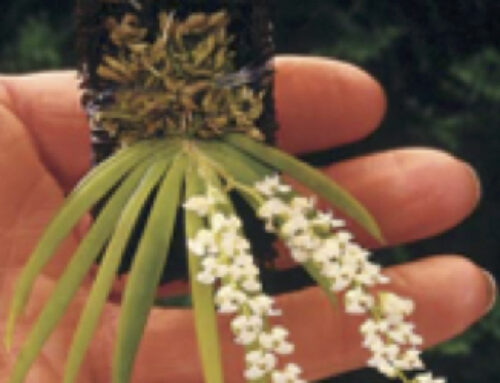By Susan Jones
Planning for the optimum health and blooms of your orchids through winter and into spring is as important as their day-to-day care. Preparing now for orchids’ seasonal nutritional needs can boost their resistance to damage from pests, disease and winter temperatures in the coming months
Overall Health
Orchids will fare better in encounters with pests, diseases and temperature extremes if they are in a good state of overall health. A plant suffering from underor over-fertilizing, or stressed from lack of water is much more likely to be injured by any additional strain.
Orchids grown under less than ideal conditions are more likely to be a target for infection or infestation. Make an extra effort now to get plants and their greenhouse or growing area in good shape for the shorter, darker days ahead by removing old foliage, weeds and dying flowers. An autumn cleanup can minimize or prevent the pest and disease problems that can crop up in the darker and more crowded conditions that often characterize the winter growing area.
General Nutrition
Light levels and temperatures begin to fall at this time of year, and your orchids’ nutritional needs change accordingly. Orchid growers can take the following steps now to help prepare their collection for optimal health through the months ahead.
If your orchids will winter outdoors, fertilizing properly can help them resist cold, insect and disease damage, as well as give them two to three additional degrees of cold resistance. This can mean the difference between a dead orchid and an unscathed plant or one that just loses a few leaves.
Use a fertilizer low in nitrogen (which should be nitrate nitrogen, not urea nitrogen) and high in potassium; the numbers on the label should read something like 10-5-20. Watering and fertilizing should be reduced in frequency for the cooler autumn season, and orchids that bloom during the winter and into spring should be given a couple of doses of blossom booster in October and November; bloom boosters should have a higher middle number, such as 10-50-10.
Ideally, this change in fertilizer should start by mid-November and continue through the end of January. This regime will sacrifice plant growth in December and January in favor of plant protection, but it can help keep the plant healthier overall.
Some growers recommend using Dyna-Gro Pro-TeKt (0-0-3), a liquid nutritional potassium-silicon supplement for plants. The product is supposed to improve heat and drought tolerance in orchids, as well as boosting their resistance to pests, disease and environmental stress.
Specific Genera
Seasonal nutritional needs differ among various orchid genera, and may diverge still further depending on local climatic conditions in disparate geographic regions. The following guidelines may require modification to accommodate individual growing conditions.
Cattleya: Watering and fertilizing frequency should be reduced, as the plants dry out more slowly in the cooler temperatures and shorter days.
Bud sheaths may yellow at this time of year as temperature fluctuations can cause water to condense inside the sheath. Should you notice condensation in the sheath, it should be opened or removed to allow the developing buds adequate air circulation and prevent bud blast caused by rots. Simply slit open the sheath and carefully peel it down toward the pseudobulb, exercising caution so as not to damage the delicate bud primordia within.
Dendrobium: Autumn and winter needs vary according to the species or hybrid parentage in this diverse genus. Dendrobium phalaenopsis and Dendrobium canaliculatum hybrids will benefit from a fertilizer with a low nitrogen formula for optimal flowering.
The leaves of Dendrobium nobile types and their hybrids begin to yellow and drop at this time of year in preparation for their winter dormancy. Plants should be given plenty of light and good air circulation and kept dry from November through February. Mist occasionally if their canes become overly shriveled.
Paphiopedilum: Generally, these do not require a great deal of fertilizer. This is especially important with the cooler-growing bulldog types to reduce nitrogen levels at this time of year for best flowering. (Bulldog Paphiopedilums have plain green leaves as opposed to the mottled-leaf types. One of the best-known bulldog-type hybrids is Paphiopedilum Winston Churchill.) Watch for water accumulating in the growth around the sheath or for late-season warm spells, as either can rot the sheath and destroy the developing inflorescence. While Paphiopedilums should not be allowed to dry out entirely, water needs are significantly reduced in the cooler days. Overwatering can cause root rot or Erwinia problems.
Phalaenopsis: Growth slows and inflorescences begin to appear. Reduce watering and fertilizing frequency, and apply a bloom-boosting fertilizer. Many growers also recommend applications of epsom salts (magnesium sulfate) to Phalaenopsis at this time of year to prevent yellowing and loss of lower leaves and to enhance blooming.
Once buds are evident on the inflorescences, keep temperatures and humidity consistent to prevent bud drop. Phalaenopsis grown in the greenhouse are especially prone to bud blast in February and early March, when the heat is still coming on at night and the greenhouse temperatures rise during the day.
Vanda: Aside from Neofinetia falcata, vandaceous orchids generally do not tolerate autumn and winter’s cooler temperatures (below 60° F [16° C]) well and need to be carefully protected from chills.
Vandaceous orchids still need as much light as possible as the days become shorter and light levels fall. Reduce the frequency of fertilizing and watering to accommodate the slower growth period they are entering.
Starting the first week of October, Julie Rosenberg at R.F. Orchids in Homestead, Florida, recommends feeding vandaceous genera a blossom booster fertilizer exclusively, once a week for four to six weeks, at 1 teaspoon per gallon of water (15 ml to 3.8 l), with normal watering between. In November, begin fertilizing every other week, using a balanced 20-20-20 fertilizer at 1 teaspoon per gallon (15 ml to 3.8 l), substituting bloom booster every fourth feeding.
Preparing now for orchids’ seasonal nutritional needs can mean happier, healthier and more productive plants year round.
—
Reprinted from the OCTOBER 2003 issue of Orchids — The Bulletin of the American Orchid Society. Copyright American Orchid Society — aos.org






